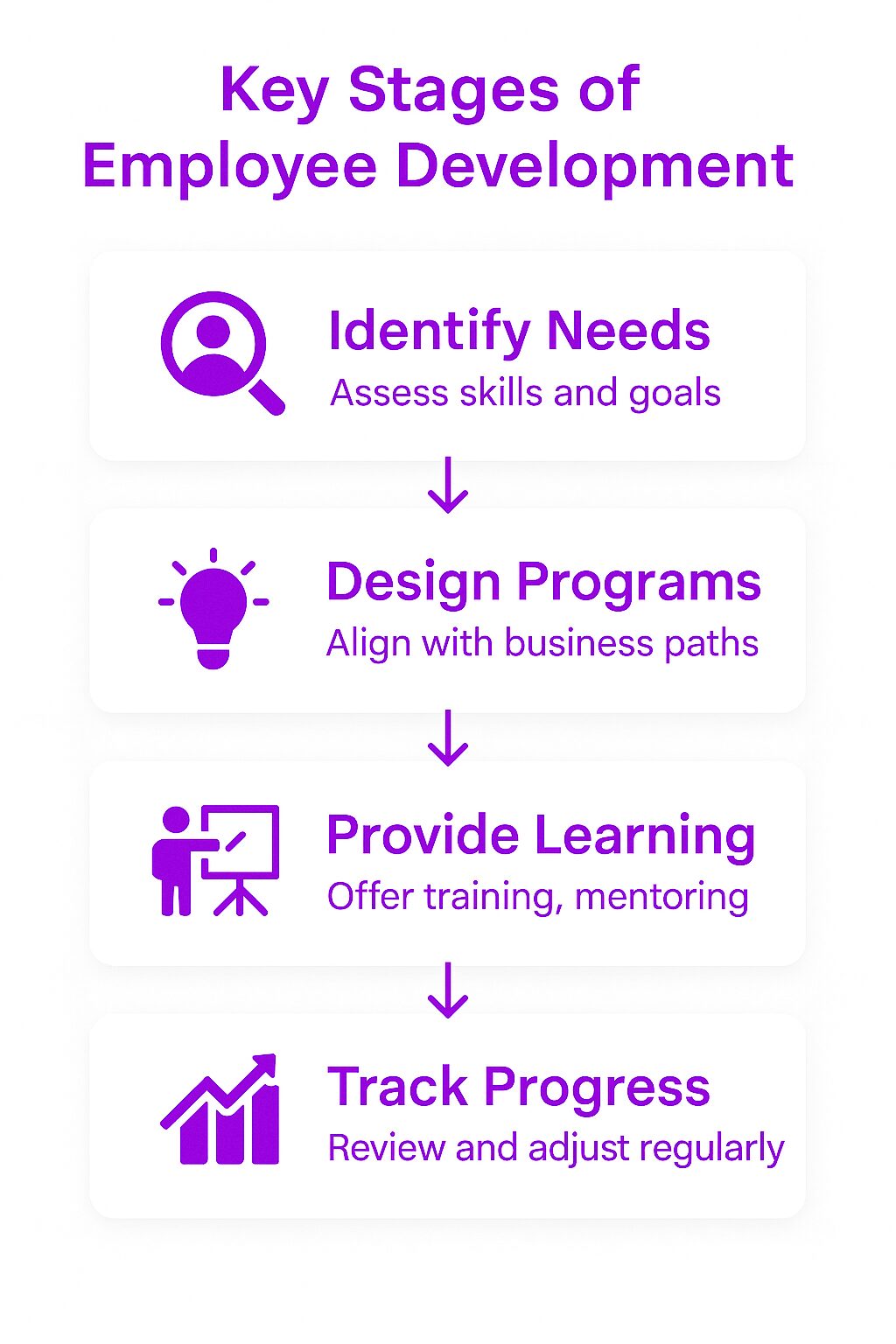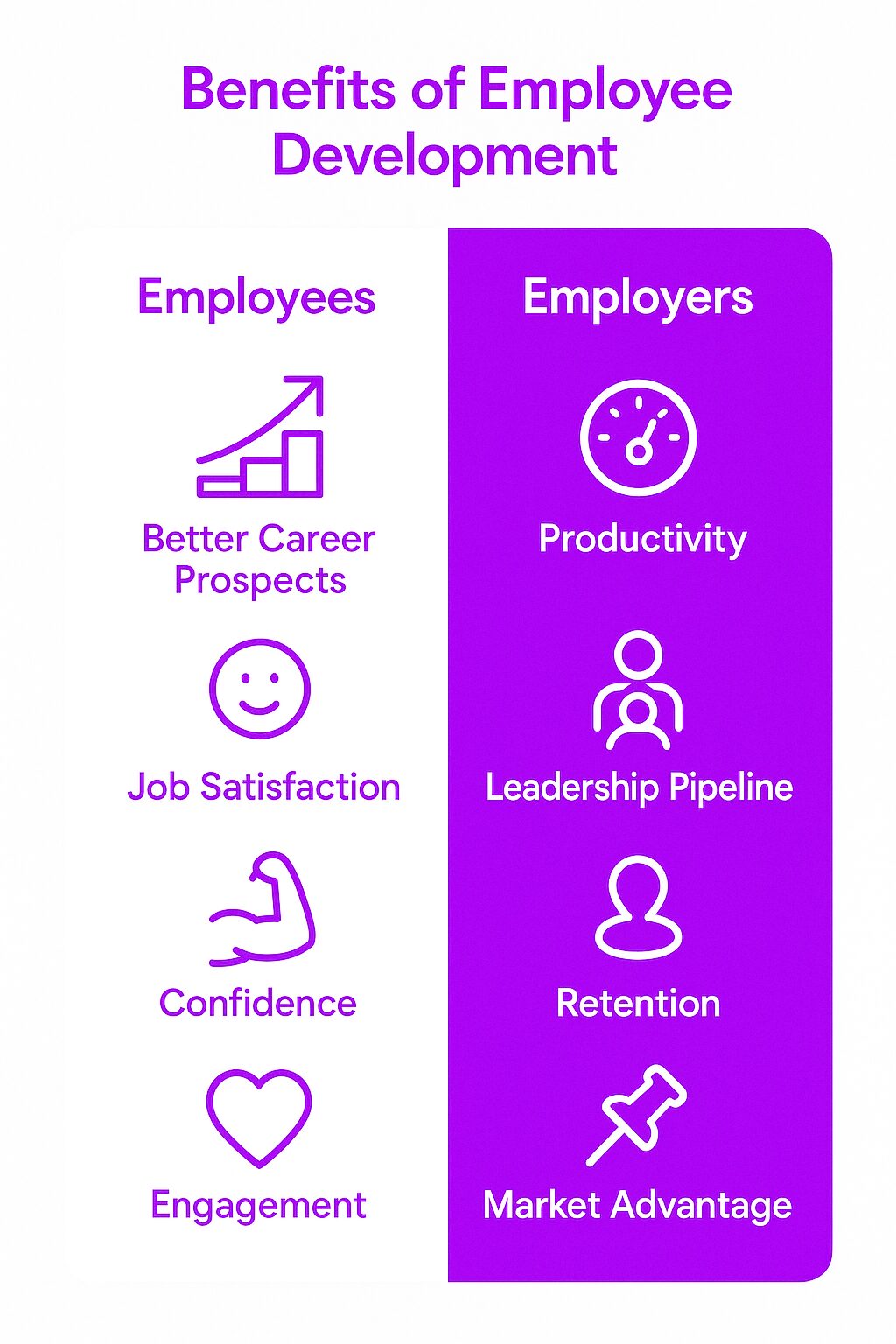What is Employee Development?
Employee development is about helping employees grow their skills, knowledge, and abilities to perform better in their current roles and prepare for future opportunities. It includes training, mentoring, hands-on learning, and exposure to new experiences. The goal is to create a workforce that is skilled, engaged, and capable of adapting to new challenges, making employee development important for organizational success.
Employee development isn’t just about formal training programs. It happens in everyday work through problem-solving, collaboration, and taking on new responsibilities. Companies that invest in development tend to retain employees longer, see higher productivity, and have stronger internal leadership pipelines.
How Employee Development Works
Successful employee development focuses on three main areas:
Experience
Employees learn best by doing. Giving them opportunities to tackle new challenges, lead projects, or take on additional responsibilities helps them grow. Hands-on experience is the most effective way to build new skills and confidence.
Exposure
Learning from others is just as important. Shadowing experienced colleagues, working with mentors, and networking with professionals in the field all contribute to development. Exposure to different perspectives and work styles broadens an employee’s ability to adapt and collaborate effectively.
Additionally, personalized career development plans are essential tools for helping employees set and achieve long-term and short-term goals.
Education
Formal learning still has a place in development. Training programs, online courses, and workshops provide structured knowledge that employees can apply to their work. Combining education with hands-on experience and exposure to new ideas creates well-rounded professionals.
Why Employee Development Matters
Employees want to grow. Career development is a critical factor in employee engagement and retention. If they don’t see opportunities for development, they’re more likely to leave for a company that invests in their growth. Investing in employee development programs significantly enhances employee retention. Organizations that prioritize development have:
-
Higher employee engagement
-
Stronger internal leadership
-
More adaptable and resilient teams
Development isn’t just about keeping employees happy. It also ensures that businesses have the skills and talent needed to stay competitive. As industries evolve, companies must keep their workforce trained and ready to meet new demands.
Creating an Effective Employee Development Plan
Creating an effective employee development plan is crucial for the growth and success of both employees and organizations. A well-structured plan helps employees acquire new skills, enhance their performance, and advance in their careers. Here are some key steps to create an effective employee development plan:
-
Identify Employee Goals and Aspirations: Start by understanding the employee’s career goals, aspirations, and interests. This personalized approach ensures that the development plan aligns with their long-term career objectives.
-
Conduct a Skills Assessment: Assess the employee’s current skills and identify areas for improvement. This helps in creating a tailored development plan that addresses specific skill gaps and leverages existing strengths.
-
Set SMART Goals: Establish Specific, Measurable, Achievable, Relevant, and Time-bound (SMART) goals. These goals should align with both the employee’s career aspirations and the organization’s objectives, ensuring mutual benefit.
-
Provide Development Opportunities: Offer a range of development opportunities, including training, mentoring, coaching, and on-the-job training. These opportunities help employees acquire new skills and knowledge, fostering continuous professional growth.
-
Regularly Review and Update the Plan: An effective employee development plan is dynamic. Regularly review and update the plan to ensure it remains relevant and effective in achieving the employee’s career goals. This ongoing process helps in adapting to changing needs and circumstances.
By following these steps, organizations can create effective employee development plans that support both individual and organizational growth.
The Key Stages of Employee Development
1. Identifying Development Needs
Before launching development initiatives, companies need to assess skill gaps and career aspirations. This can be done through:
-
Performance reviews
-
Employee feedback
-
Skills assessments
-
Career goal discussions
2. Designing Development Programs
Once the needs are clear, companies can create an employee development program that aligns with business goals and employee career paths. Programs should be flexible and tailored to individual needs.
3. Providing Learning Opportunities
Employees should have access to a mix of on-the-job learning, mentoring, and formal education. A good development program includes:
-
Stretch assignments
-
Cross-training
-
Job rotations
-
Coaching and mentorship
Offering high-quality training and development opportunities can significantly enhance employee retention, aligning workforce capabilities with business goals.
4. Tracking Progress and Adjusting
Development should be an ongoing process with regular check-ins. Managers should:
-
Provide feedback
-
Adjust development plans as needed
-
Celebrate progress and achievements
Development Opportunities
Development opportunities are essential for employee growth and career advancement. Here are some types of development opportunities that organizations can offer:
-
Training and Development Programs: Structured training and development programs are fundamental. These programs can cover a wide range of topics, from leadership development and communication skills to technical skills, helping employees stay current and competitive.
-
Mentoring and Coaching: Providing mentoring and coaching opportunities allows employees to receive guidance and support from experienced professionals. This personalized approach helps in navigating career paths and overcoming challenges.
-
On-the-Job Training: On-the-job training is invaluable for practical learning. It allows employees to gain hands-on experience and develop new skills in a real-world context, enhancing their competence and confidence.
-
Cross-Functional Training: Cross-functional training opportunities enable employees to learn about different departments and functions within the organization. This broadens their understanding and prepares them for diverse roles and responsibilities.
-
Leadership Development Programs: Leadership development programs are designed to cultivate leadership skills. These programs prepare employees for future leadership roles, ensuring a strong internal pipeline of capable leaders.
Offering a variety of development opportunities helps in creating a well-rounded and skilled workforce, ready to meet the challenges of today and tomorrow.
Benefits of Employee Development
For Employees
-
Better career prospects
-
Increased job satisfaction
-
Higher confidence in their skills
-
More engagement and motivation at work
For Employers
-
Improved productivity
-
Stronger leadership pipeline
-
Higher retention rates
-
Competitive advantage in the job market
-
Structured and accessible employee development programs that foster engagement, retain talent, and build a strong company culture
Common Challenges in Employee Development
Budget Constraints
Not all companies have the resources for large training programs. However, development doesn’t have to be expensive. Encouraging mentorship, providing access to free online resources, and leveraging internal knowledge-sharing can be cost-effective alternatives.
Lack of Employee Engagement
Some employees may not take advantage of development opportunities. To address this, companies should:
-
Align development with employees’ career goals
-
Make learning relevant to day-to-day work
-
Recognize and reward participation
-
Encourage employees to create their own employee development plan
Inconsistent Implementation
Development programs often fail due to poor execution. To ensure success:
-
Leadership must support and participate in development efforts
-
Programs should be clearly communicated and easy to access
-
Progress should be measured and adjusted as needed
Measuring Success
Tracking the impact of development programs can be challenging. Companies should:
-
Use employee feedback and performance metrics
-
Set clear development goals
-
Monitor long-term career growth of employees
Company Culture and Employee Development
Company culture plays a significant role in employee development. A positive company culture that supports employee growth and development can lead to increased employee engagement, retention, and productivity. Here are some ways to create a company culture that supports employee development:
-
Encourage a Learning Culture: Foster a learning culture that values continuous growth and development. Encourage employees to seek out professional development opportunities and support their efforts to learn and improve.
-
Provide Opportunities for Feedback: Regular feedback and coaching are essential for development. Create an environment where employees feel comfortable receiving and giving feedback, helping them to continuously improve their performance.
-
Recognize and Reward Employee Achievements: Recognizing and rewarding employee achievements and contributions is crucial. This not only motivates employees but also reinforces the importance of development and growth within the organization.
-
Foster a Collaborative Work Environment: A collaborative work environment encourages teamwork, communication, and knowledge sharing. This collective approach to problem-solving and innovation enhances overall employee development.
-
Support Work-Life Balance: Supporting work-life balance is key to maintaining employee well-being. Offer flexible work arrangements and employee wellness programs to help employees manage their personal and professional lives effectively.
By creating a company culture that prioritizes employee development, organizations can ensure that their workforce remains engaged, motivated, and ready to take on new challenges.
Best Practices for Employee Development
Create a Learning Culture
Development should be part of daily work, not just a scheduled training session. Encouraging knowledge-sharing and giving employees time for self-directed learning can make a big difference.
Provide Opportunities for Growth
Employee training and development is essential for providing opportunities for growth. Assigning them to new projects, encouraging lateral moves, and offering leadership opportunities all contribute to development.
Leverage Technology
Online learning platforms, webinars, and digital resources make development more accessible. Companies can use these tools to provide flexible, on-demand training.
Encourage Mentorship and Coaching
Experienced employees can help others grow. A strong mentorship program fosters knowledge transfer and professional growth.
Align Development with Business Goals
Development efforts should support the company’s strategic objectives. If the business is expanding into new markets, employees should be trained in relevant skills to support that growth.
Related Concepts
Employee Training vs. Employee Development
Training is typically short-term and focused on specific skills. Development is a long-term investment in an employee’s growth.
Leadership Development
Preparing employees for management and executive roles requires specialized training, mentoring, and leadership experiences.
Employee Engagement
Development plays a key role in keeping employees engaged and motivated. A lack of growth opportunities is a common reason for disengagement.
Real-World Examples of Employee Development
Google’s 20% Rule
Google allows employees to spend 20% of their work time on personal projects that benefit the company. This policy encourages innovation and skill development.
Amazon Career Choice
Amazon covers tuition fees for employees pursuing education in high-demand fields, helping them advance their careers both within and outside the company.
Social Learning in Companies
Some companies use digital communities where employees can share knowledge, ask questions, and learn from peers. This informal approach to development fosters collaboration and engagement.
Final Thoughts
Employee development is an ongoing investment that benefits both employees and companies. Organizations that prioritize growth see higher retention, stronger leadership, and a more adaptable workforce. Development doesn’t have to be costly or complex—small efforts, like mentorship and hands-on learning, can make a significant impact. The key is to create a culture where continuous learning is encouraged and valued.







